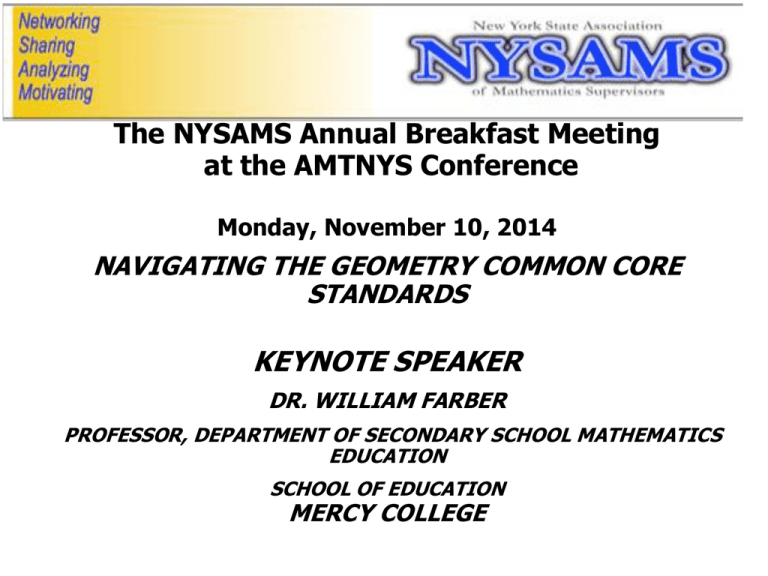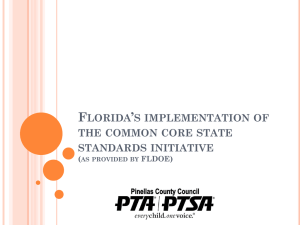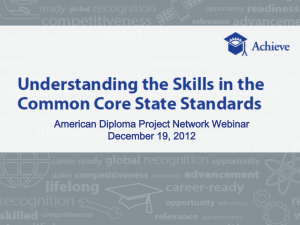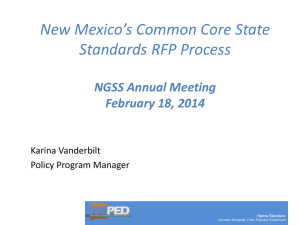Dr. William Farber`s presentation from 2014 NYSAMS Breakfast
advertisement

The NYSAMS Annual Breakfast Meeting at the AMTNYS Conference Monday, November 10, 2014 NAVIGATING THE GEOMETRY COMMON CORE STANDARDS KEYNOTE SPEAKER DR. WILLIAM FARBER PROFESSOR, DEPARTMENT OF SECONDARY SCHOOL MATHEMATICS EDUCATION SCHOOL OF EDUCATION MERCY COLLEGE NAVIGATING THE GEOMETRY COMMON CORE STANDARDS Dr. William Farber Mercy College New York State P-12 Common Core Learning Standards for Mathematics This document includes all of the Common Core State Standards in Mathematics plus the New York recommended additions. All of the New York State Mathematics Common Core Workgroup’s recommended additions are included within this document highlighted in yellow under the related The Common Core Geometry Modules Texts Technology Tools Hands-on Resources Common Core Geometry Although there are many types of geometry, school mathematics is devoted primarily to plane Euclidean geometry, studied both synthetically (without coordinates) and analytically (with coordinates). Euclidean geometry is characterized most importantly by the Parallel Postulate, that through a point not on a given line there is exactly one parallel line. The Geometry Content is divided into domains, clusters, and standards. • Domains are larger groups of related clusters and standards. Standards from different domains may be closely related. • Clusters are groups of related standards. Note that standards from different clusters may sometimes be closely related, because mathematics is a connected subject. • Standards define what students should understand and be able to do. In some cases, standards are further articulated into lettered components. 14 How to read the geometry content standards Domain Congruence G-CO Standard Experiment with transformations in the plane 1. Know precise definitions of angle, circle, perpendicular line, parallel line, and line segment, based on the undefined notions of point, line, distance along a line, and distance around a circular arc. 2. Represent transformations in the plane using, e.g., transparencies and geometry software; describe transformations as functions that take points in the plane as inputs and give other points as outputs. Compare transformations that preserve distance and angle to those that do not (e.g., translation versus horizontal stretch). 3. Given a rectangle, parallelogram, trapezoid, or regular polygon, describe the rotations and reflections that carry it onto itself. 4. Develop definitions of rotations, reflections, and translations in terms of angles, circles, perpendicular lines, parallel lines, and line segments. 5. Given a geometric figure and a rotation, reflection, or translation, draw the transformed figure using, e.g., graph paper, tracing paper, or geometry software. Specify a sequence of transformations that will carry a given figure onto another. Cluster Understanding the format and designations of the CCLS Domain FOCUS STANDARD: Congruence •G-CO - Congruence • Standard: Experiment with transformations in a plane - Clusters: (G-CO.1 – G-CO.5) • Standard : Understand congruence in terms of Standard & Associated Clusters rigid motions - Clusters: (G-CO.6 – G-CO.8) • Standard: Prove geometric theorems Clusters: (G-CO.9 – G-CO.11) • Standard: Make geometric constructions Clusters: (G-CO.12–G-CO.13) Understanding the format and designations of the CCLS FOCUS STANDARD: G-SRT Similarity, right triangles, and trigonometry Domain Standard & Associated Clusters Extention Standard • G-SRT – Similarity, Right Triangles, & Trigonometry • Standard: Understand similarity in terms of similarity transformationsClusters: (G-SRT.A.1 – G-SRT.A.3) • Standard : Prove theorems involving similarity- Clusters: (G-SRT.B.4 – G-SRT.B.5) • Standard: Define trig ratios & solve problems involving right triangles Clusters: (G-SRT.C.6 – G-SRT.C.8) Standard: Applying trigonometry to general triangles: Clusters: (G-SRT.D.9 – G-SRT.D.11) Understanding the format and designations of the CCLS FOCUS STANDARD: G-C Similarity, right triangles, and trigonometry Domain Standard & Associated Clusters Extention Standards • G-C – Circles • Standard: Understand and apply theorems about circles - Clusters: (G-C.A.1 - G-C.A.3) • Standard : Find arc lengths and areas of sectors of circles – Cluster: (G-C.B.5) • Standard: Translate between the geometric description and the equation for a conic section – Clusters (G-GPE.A.1) • Standard: Use coordinates to prove simple geometric theorems algebraically Cluster: (G-GPE.B.4) Standard: Understand and apply theorems about circles - Cluster: (G-C.A.4) Standard: Apply trig to general triangles Cluster: G-SRT.D.9 Understanding the format and designations of the CCLS FOCUS STANDARD: G-GPE Expressing geometric properties with equations • G-GPE – Expressing geometric properties Domain with equations Standard & Associated Clusters • Standard: Explain volume formulas and use them to solve problems-Clusters: (G-GMD.A.1 - G-GMD.A.3) • Standard: Visualize relationships between two-dimensional & three-dimensional objects – Clusters (G-GMD.B.4) • Standard: Apply geometric concepts in modeling situations Cluster: (G-MG.A.1-G-MG.A.3) Understanding the format and designations of the CCLS FOCUS STANDARD: G-GMD Geometric measurement and dimension Domain • G-GMD Standard & Associated Clusters • Standard: Explain volume formulas and use them to solve problems - Clusters: (G-GPE.B.4 G-GPE.B.7) • Standard: Translate between the geometric description and the equation for a conic section – Clusters (G-GPE.A.1) • Standard: Use coordinates to prove simple geometric theorems algebraically Cluster: (G-GPE.B.4) Extention Standard Standard: Explain volume formulas and use them to solve problems – Cluster: G-GMD.A.2 Understanding the format and designations of the CCLS FOCUS STANDARD: G-GMD Geometric measurement and dimension Domain • G-G-MG – Modeling with geometry Standard & Associated Clusters • Standard: Apply geometric concepts in modeling situationsClusters: (G-MG.A.1 – G-MG.A.3) The Standards for Mathematical Practice 1. Make sense of complex problems and persevere in solving them. 2. Reason abstractly and quantitatively 3. Construct viable arguments and critique the reasoning of others. 4. Model with mathematics. 5. Use appropriate tools strategically. 6. Attend to precision. 7. Look for and make use of structure. 8. Look for and express regularity in repeated reasoning. Grouping the Standards of Mathematical Practice Discussion of Mathematical Practices in Relation to Course Content •Construct viable arguments and critique the reasoning of others(MP.3). Conjecture vs Proof •Use appropriate tools strategically(MP.5). Dynamic geometry environments for geometric constructions, and the constructions in such environments can sometimes lead to an idea behind a proof of a conjecture. •Attend to precision(MP.6). Creating definitions as a way to help students see the value of precision. For example, a class can build the definition of quadrilateral by starting with a rough idea (“four sides”), gradually refining the idea so that it rules out figures that do not fit the intuitive idea. •Look for and make use of structure(MP.7). Seeing structure in geometric can lead to insights and proofs. This often involves the creation of auxiliary lines not originally part of a given figure. Shifts in Mathematics Shift 1 Focus Teachers significantly narrow and deepen the scope of how time and energy is spent in the math classroom. They do so in order to focus deeply on only the concepts that are prioritized in the standards. Shift 2 Coherence Principals and teachers carefully connect the learning within and across grades so that students can build new understanding onto foundations built in previous years. Shift 3 Fluency Students are expected to have speed and accuracy with simple calculations; teachers structure class time and/or homework time for students to memorize, through repetition, core functions. Shift 4 Deep Understanding Students deeply understand and can operate easily within a math concept before moving on. They learn more than the trick to get the answer right. They learn the math. Shift 5 Application Students are expected to use math and choose the appropriate concept for application even when they are not prompted to do so. Shift 6 Dual Intensity Students are practicing and understanding. There is more than a balance between these two things in the classroom – both are occurring with intensity. 27 The Modules • • • • • • • • Teacher Materials Student Materials Copy Ready Materials Module Overview Mid-Module Assessment End-of-Module Assessment Module Overview and Assessments Topic Overviews documents Three Levels of Content Standards Scaffolding: For students with eye-hand coordination or visualization problems, model the Opening Exercise as a class, and then provide students with a copy of the work to complete the exploration. For advanced learners, explain the paper pushing puzzle, and let them come up with a hypothesis on what they are creating and how they can prove it without seeing questions. Vertical Alignment - Common Core Geometry Kindergarten Identify and describe shapes. CCSS.Math.Content.K.G.A.1 Describe objects in the environment using names of shapes, and describe the relative positions of these objects using terms such as above, below, beside, in front of, behind, and next to. CCSS.Math.Content.K.G.A.2 Correctly name shapes regardless of their orientations or overall size. CCSS.Math.Content.K.G.A.3 Identify shapes as two-dimensional (lying in a plane, "flat") or three-dimensional ("solid"). Analyze, compare, create, and compose shapes. CCSS.Math.Content.K.G.B.4 Analyze and compare two- and three-dimensional shapes, in different sizes and orientations, using informal language to describe their similarities, differences, parts (e.g., number of sides and vertices/"corners") and other attributes (e.g., having sides of equal length). CCSS.Math.Content.K.G.B.5 Model shapes in the world by building shapes from components (e.g., sticks and clay balls) and drawing shapes. CCSS.Math.Content.K.G.B.6 Compose simple shapes to form larger shapes. For example, "Can you join these two triangles with full sides touching to make a rectangle?" Vertical Alignment - Common Core Geometry Grade 1 Reason with shapes and their attributes CCSS.Math.Content.1.G.A.1 Distinguish between defining attributes (e.g., triangles are closed and three-sided) versus non-defining attributes (e.g., color, orientation, overall size); build and draw shapes to possess defining attributes. CCSS.Math.Content.1.G.A.2 Compose two-dimensional shapes (rectangles, squares, trapezoids, triangles, halfcircles, and quarter-circles) or three-dimensional shapes (cubes, right rectangular prisms, right circular cones, and right circular cylinders) to create a composite shape, and compose new shapes from the composite shape.1 CCSS.Math.Content.1.G.A.3 Partition circles and rectangles into two and four equal shares, describe the shares using the words halves, fourths, and quarters, and use the phrases half of, fourth of, and quarter of. Describe the whole as two of, or four of the shares. Understand for these examples that decomposing into more equal shares creates smaller shares. Vertical Alignment - Common Core Geometry Grade 2 Reason with shapes and their attributes CCSS.Math.Content.2.G.A.1 Recognize and draw shapes having specified attributes, such as a given number of angles or a given number of equal faces.1 Identify triangles, quadrilaterals, pentagons, hexagons, and cubes. CCSS.Math.Content.2.G.A.2 Partition a rectangle into rows and columns of same-size squares and count to find the total number of them. CCSS.Math.Content.2.G.A.3 Partition circles and rectangles into two, three, or four equal shares, describe the shares using the words halves, thirds, half of, a third of, etc., and describe the whole as two halves, three thirds, four fourths. Recognize that equal shares of identical wholes need not have the same shape. Vertical Alignment - Common Core Geometry Grade 3 Reason with shapes and their attributes. CCSS.Math.Content.3.G.A.1 Understand that shapes in different categories (e.g., rhombuses, rectangles, and others) may share attributes (e.g., having four sides), and that the shared attributes can define a larger category (e.g., quadrilaterals). Recognize rhombuses, rectangles, and squares as examples of quadrilaterals, and draw examples of quadrilaterals that do not belong to any of these subcategories. CCSS.Math.Content.3.G.A.2 Partition shapes into parts with equal areas. Express the area of each part as a unit fraction of the whole. For example, partition a shape into 4 parts with equal area, and describe the area of each part as 1/4 of the area of the shape. Vertical Alignment - Common Core Geometry Grade 4 Draw and identify lines and angles, and classify shapes by properties of their lines and angles. CCSS.Math.Content.4.G.A.1 Draw points, lines, line segments, rays, angles (right, acute, obtuse), and perpendicular and parallel lines. Identify these in two-dimensional figures. CCSS.Math.Content.4.G.A.2 Classify two-dimensional figures based on the presence or absence of parallel or perpendicular lines, or the presence or absence of angles of a specified size. Recognize right triangles as a category, and identify right triangles. CCSS.Math.Content.4.G.A.3 Recognize a line of symmetry for a two-dimensional figure as a line across the figure such that the figure can be folded along the line into matching parts. Identify linesymmetric figures and draw lines of symmetry. Vertical Alignment - Common Core Geometry Grade 5 Graph points on the coordinate plane to solve real-world and mathematical problems. CCSS.Math.Content.5.G.A.1 Use a pair of perpendicular number lines, called axes, to define a coordinate system, with the intersection of the lines (the origin) arranged to coincide with the 0 on each line and a given point in the plane located by using an ordered pair of numbers, called its coordinates. Understand that the first number indicates how far to travel from the origin in the direction of one axis, and the second number indicates how far to travel in the direction of the second axis, with the convention that the names of the two axes and the coordinates correspond (e.g., x-axis and x-coordinate, y-axis and y-coordinate). CCSS.Math.Content.5.G.A.2 Represent real world and mathematical problems by graphing points in the first quadrant of the coordinate plane, and interpret coordinate values of points in the context of the situation. Classify two-dimensional figures into categories based on their properties. CCSS.Math.Content.5.G.B.3 Understand that attributes belonging to a category of two-dimensional figures also belong to all subcategories of that category. For example, all rectangles have four right angles and squares are rectangles, so all squares have four right angles. CCSS.Math.Content.5.G.B.4 Classify two-dimensional figures in a hierarchy based on properties. Vertical Alignment - Common Core Geometry Grade 6 Solve real-world and mathematical problems involving area, surface area, and volume. CCSS.Math.Content.6.G.A.1 Find the area of right triangles, other triangles, special quadrilaterals, and polygons by composing into rectangles or decomposing into triangles and other shapes; apply these techniques in the context of solving real-world and mathematical problems. CCSS.Math.Content.6.G.A.2 Find the volume of a right rectangular prism with fractional edge lengths by packing it with unit cubes of the appropriate unit fraction edge lengths, and show that the volume is the same as would be found by multiplying the edge lengths of the prism. Apply the formulas V = l w h and V = b h to find volumes of right rectangular prisms with fractional edge lengths in the context of solving real-world and mathematical problems. CCSS.Math.Content.6.G.A.3 Draw polygons in the coordinate plane given coordinates for the vertices; use coordinates to find the length of a side joining points with the same first coordinate or the same second coordinate. Apply these techniques in the context of solving real-world and mathematical problems. CCSS.Math.Content.6.G.A.4 Represent three-dimensional figures using nets made up of rectangles and triangles, and use the nets to find the surface area of these figures. Apply these techniques in the context of solving real-world and mathematical problems. Vertical Alignment - Common Core Geometry Grade 7 Draw construct, and describe geometrical figures and describe the relationships between them. CCSS.Math.Content.7.G.A.1 Solve problems involving scale drawings of geometric figures, including computing actual lengths and areas from a scale drawing and reproducing a scale drawing at a different scale. CCSS.Math.Content.7.G.A.2 Draw (freehand, with ruler and protractor, and with technology) geometric shapes with given conditions. Focus on constructing triangles from three measures of angles or sides, noticing when the conditions determine a unique triangle, more than one triangle, or no triangle. CCSS.Math.Content.7.G.A.3 Describe the two-dimensional figures that result from slicing three-dimensional figures, as in plane sections of right rectangular prisms and right rectangular pyramids. Solve real-life and mathematical problems involving angle measure, area, surface area, and volume. CCSS.Math.Content.7.G.B.4 Know the formulas for the area and circumference of a circle and use them to solve problems; give an informal derivation of the relationship between the circumference and area of a circle. CCSS.Math.Content.7.G.B.5 Use facts about supplementary, complementary, vertical, and adjacent angles in a multi-step problem to write and solve simple equations for an unknown angle in a figure. CCSS.Math.Content.7.G.B.6 Solve real-world and mathematical problems involving area, volume and surface area of two- and three-dimensional objects composed of triangles, quadrilaterals, polygons, cubes, and right prisms. Vertical Alignment - Common Core Geometry Grade 8 Understand congruence and similarity using physical models, transparencies, or geometry software. CCSS.Math.Content.8.G.A.1 Verify experimentally the properties of rotations, reflections, and translations: CCSS.Math.Content.8.G.A.1.a Lines are taken to lines, and line segments to line segments of the same length. CCSS.Math.Content.8.G.A.1.b Angles are taken to angles of the same measure. CCSS.Math.Content.8.G.A.1.c Parallel lines are taken to parallel lines. CCSS.Math.Content.8.G.A.2 Understand that a two-dimensional figure is congruent to another if the second can be obtained from the first by a sequence of rotations, reflections, and translations; given two congruent figures, describe a sequence that exhibits the congruence between them. CCSS.Math.Content.8.G.A.3 Describe the effect of dilations, translations, rotations, and reflections on two-dimensional figures using coordinates. CCSS.Math.Content.8.G.A.4 Understand that a two-dimensional figure is similar to another if the second can be obtained from the first by a sequence of rotations, reflections, translations, and dilations; given two similar twodimensional figures, describe a sequence that exhibits the similarity between them. Vertical Alignment - Common Core Geometry Grade 8 (Continued) Understand congruence and similarity using physical models, transparencies, or geometry software (continued) CCSS.Math.Content.8.G.A.5 - Use informal arguments to establish facts about the angle sum and exterior angle of triangles, about the angles created when parallel lines are cut by a transversal, and the angle-angle criterion for similarity of triangles. For example, arrange three copies of the same triangle so that the sum of the three angles appears to form a line, and give an argument in terms of transversals why this is so. Understand and apply the Pythagorean Theorem. CCSS.Math.Content.8.G.B.6 - Explain a proof of the Pythagorean Theorem and its converse. CCSS.Math.Content.8.G.B.7 - Apply the Pythagorean Theorem to determine unknown side lengths in right triangles in real-world and mathematical problems in two and three dimensions. CCSS.Math.Content.8.G.B.8 - Apply the Pythagorean Theorem to find the distance between two points in a coordinate system. Solve real-world and mathematical problems involving volume of cylinders, cones, and spheres. CCSS.Math.Content.8.G.C.9 - Know the formulas for the volumes of cones, cylinders, and spheres and use them to solve real-world and mathematical problems. Grade 8 Sample Items – Common Core Geometry Protocols Procedure Adminstration Transition to Common Core Geometry Regents Test Guide Regents Examination in Geometry (Common Core) Blueprint Conceptual Category Domains in Geometry Congruence (G-CO) 27% - 34% Similarity, Right Triangles, and Trigonometry (G-SRT) 29% - 37% Circles (G-C) Geometry EngageNY.org Percent of Test By Credit 2% - 8% Expressing Geometric Properties with Equations (G-GPE) 12% - 18% Geometric Measurement & Dimensions (G-GMD) 2% - 8% Modeling with Geometry (G-GMD) 8% - 15% 52 Test Guide Content Chart Conceptual Category Domain Cluster Experiment with transformations in the plane Congruence 27% - 34% Cluster Emphasis Supporting Understand congruence in terms of rigid motions Major Prove geometric theorems Make geometric constructions Supporting Understand similarity in terms of similarity transformations Similarity, Right Triangles, & Trigonometry 29% - 37% Geometry Prove theorems involving similarity Major Define trigonometric ratios and solve problems involving right triangles Circles 2% - 8% Understand and apply theorems about circles Additional Find arc lengths and areas of sectors of circles Translate between the geometric description and the equation for a conic section Expressing Geometric Properties with Equations 12% - 18% Geometric Measurement & Dimensions 2% - 8% EngageNY.org Modeling with Geometry 8% - 15% Use coordinates to prove simple geometric theorems algebraically Additional Major Additional Visualize relationships between two-dimensional and three-dimensional objects 53 G-CO.1 G-CO.2 G-CO.3 G-CO.4 G-CO.5 G-CO.6 G-CO.7 G-CO.8 G-CO.9 G-CO.10 G-CO.11 G-CO.12 G-CO.13 G-SRT.1a G-SRT.1b G-SRT.2 G-SRT.3 G.SRT.4 G.SRT.5 G.SRT.6 G.SRT.7 G.SRT.8 G.C.1 G.C.2 G.C.3 G.C.5 Explain volume formulas and use them to solve problems Apply geometric concepts in modeling situations Standard G.GPE.1 G.GPE.4 G.GPE.5 G.GPE.6 G.GPE.7 G.GMD.1 G.GMD.3 G.GMD.4 Major G.MG.1 G.MG.2 G.MG.3 Test Guide Question Format Part I – Multiple-Choice Questions Parts II, III, IV – Constructed-Response Questions Regents Examination in Geometry (Common Core) Design Test Component Number of Questions Credits per Question Total Credits in Section Part I 24 2 48 Part II 8 2 16 Part III 4 4 16 Part IV 1 6 6 Total 37 - 86 EngageNY.org 54 Test Guide Mathematics Tools for the Regents Examination in Geometry (Common Core) • Graphing Calculator • Straightedge • Compass 55 Question Types & Development Question Types • Multiple-Choice Questions • Constructed-Response Questions 56 Question Types & Development Question Types Multiple-Choice Questions • primarily used to assess procedural fluency and conceptual understanding • measure the Standards for Mathematical Content • may incorporate Standards for Mathematical Practices and real-world applications • some questions require multiple steps 57 Question Types & Development Question Types Constructed-Response Questions (2-credit) • students are required to show their work • may involve multiple steps • the application of multiple mathematics skills • real-world applications • may require students to explain or justify their solutions and/or show their process of problem solving 58 Question Types & Development Question Types Constructed-Response Questions (4-,6-credit) • require students to show their work in completing more extensive problems which may involve multiple tasks and concepts • students will need to reason abstractly and quantitatively • students may need to construct viable arguments to justify and/or prove geometric relationships in order to demonstrate procedural and conceptual understanding 6-credit constructed-response questions • students will develop multi-step, extended logical arguments and proofs involving major content and/or use modeling to solve real-world and mathematical application problems Development: Item-Writing Guidelines These guidelines for writing multiple-choice and constructed-response items serve to ensure that the items included on operational exams meet certain standards for alignment to curriculum, fairness, clarity, and overall quality. • Using these guidelines to draft questions is one of many steps employed to help ensure a valid, fair, and quality assessment. • Draft questions that meet these criteria are allowed to move forward in the development process. The next step is for the items to be reviewed, and edited when necessary, by a Committee of certified New York State educators. Only items that are approved by the educator panel are allowed to be field-tested. 60 Standards Clarifications In an effort to ensure that the standards can be interpreted by teachers and used effectively to inform classroom instruction, several standards of the Geometry curriculum have been identified as needing some clarification. These clarifications are outlined below. • G-CO.3 Trapezoid is defined as “A quadrilateral with at least one pair of parallel sides.” • G-CO.10, G-CO.11, G-SRT.4 Theorems include but are not limited to the listed theorems. • G-CO.12 Constructions include but are not limited to the listed constructions. • G-SRT.5 ASA, SAS, SSS, AAS, and Hypotenuse-Leg theorem are valid criteria for triangle congruence. AA, SAS, and SSS are valid criteria for triangle similarity. • G-C.2 Relationships include but are not limited to the listed relationships. 61 A transformational conception of similarity would enable a student to determine correspondence and set up a correct proportion. If a student understood that two figures are similar if one is congruent to a dilation of the other, then they could easily determine that a 3-dilation of the smaller triangle (ABE), centered at point A, yields the larger triangle (ACD). The student would know the scale factor is 3 because the side of 3 units is enlarged to a corresponding side of 9 units. Reflective Writing Assignment How would you define congruence? How would you define similarity? 68 Rigid motion A transformation of points in space consisting of a sequence of one or more translations, reflections, and/or rotations. Rigid motions are here assumed to preserve distances and angle measures. Why are TRANSFORMATIONS THE SPINE OF THE CORE? Isometries & Rigid Motions in the plane preserve distances, angles, betweeness and collinearity within transformed shapes. This leads to our new definition of congruence. Two figures are CONGRUENT if and only if one can be obtained from the other by one or a sequence of rigid motions. The non-isometric transformation of dilation leads us to investigating similarity. This definition is also revised to be viewed in the light of transformations. Two plane figures are SIMILAR if and only if one can be obtained from the other by one or a sequence of similarity transformations. (Similarity transformations included reflection, rotation, translation and dilation.) Defining Congruence & Similarity through Transformations 72 Congruent polygons Congruent polygons have an equal number of sides, and all the corresponding sides and angles are congruent. However, they can be in a different location, rotated or flipped over. So for example the two triangles shown below are congruent even though one is a mirror image of the other. Definition of Congruence & Similarity Used in the CCSS A two-dimensional figure is congruent to another if the second can be obtained from the first by a sequence of rotations, reflections, and translations. A two-dimensional figure is similar to another if the second can be obtained from the first by a sequence of rotations, reflections, translations and dilations. Geometry Regents 2014– Item #36 The Pythagorean theorem states that if three squares are drawn on the sides of a right triangle, then the area of the largest square equals the sum of the areas of the two remaining squares. There must be a point P along the hypotenuse of the right triangle at which the large square is divided into two rectangles as shown, each with area matching the area of one of the smaller squares. Consider a right triangle AOB situated on the coordinate plane with vertex A on the positive y-axis, O the origin and vertex B on the positive x-axis. Suppose A has coordinates (0,a), B has coordinates (b,0), and the length of the hypotenuse (𝐴𝐵) is c. a. Find the coordinates of a point P on the line segment 𝐴𝐵 such that 𝑂𝑃 is perpendicular to 𝐴𝐵. b. Show that for this point 𝑃 we have AP = PB = a2 b 2 2 a +b 2 2 ab + −a 2 a2 +b a2 b b− 2 2 a +b 2 6 4 AP a b +b = = 6 2 4 PB b +a b 2 2 ab + 2 2 a +b 2 2 4 a (b +a ) = 4 2 2 b (b +a ) 𝐴𝑃 𝑃𝐵 = 𝑎2 . 𝑏2 2 , 2 a4 a2 = 2 4 b b Show that if we draw from P a line perpendicular to (𝐴𝐵), then that line divides the square with 𝐴𝐵 as one of its sides into two rectangles, one of area a² and one of area b². c. Historical Perspectives and Famous Mathematicians Thales of Miletus (624 – 526 BC) Exploratory Challenge – CCSS Module 5, Lesson 1 Cavalieri's Principle If, in two solids of equal altitude, the sections made by planes parallel to and at the same distance from their respective bases are always equal, then the volumes of the two solids are equal Bonaventura Francesco Cavalieri was an Italian mathematician. He is known for his work on the problems of optics and motion, Born: 1598, Milan, Italy Died: November 30, 1647, Bologna, Italy Education: University of Pisa Geometry Module Two – Class Discussion Common Core Geometry Resources Common Core Geometry Sample Exam Items Questions https://www.engageny.org/resource/regents-exams-mathematics-geometrysample-items Basic Geometric Constructions https://www.youtube.com/watch?v=UZjevRGLjTM January, 2014 Geometry Regents (Video Tutorial) https://www.youtube.com/watch?v=24rzEMBH9d0 Geometry Regents, June, 2014 http://www.nysedregents.org/geometry/614/geom62014-exam.pdf PARCC Discussion of Mathematical Practices in Relation to Course Content (Geometry) http://parcconline.org/mcf/mathematics/discussion-mathematical-practicesrelation-course-content-0 Common Core Geometry Resources New York State Common Core Geometry Standards Clarifications https://www.engageny.org/resource/regents-exams-mathematics-geometrystandards-clarifications Video 2014 Geometry Regents https://www.engageny.org/resource/regents-exams-mathematics-geometrystandards-clarifications Website summarizing the Geometry Common Core http://www.corestandards.org/Math/Content/HSG/introduction/ Great Teacher Website on Geometry Common Core http://geometrycommoncore.com/ Common Core Geometry Resources By Grade http://www.insidemathematics.org/common-core-resources/mathematicalcontent-standards/standards-by-grade/high-school-geometry Common Core Geometry Resources Shmoop – CCSS Resource for Students http://www.shmoop.com/common-core-standards/ccss-hs-g-gmd-1.html Virtual Nerd – Helpful Video Tutorials for Students http://www.virtualnerd.com/common-core/hsf-geometry/HSG-GMD-measurement-dimension/ Prepare your students with our new Common Core math skills (8th Grade Geometry) https://www.khanacademy.org/commoncore/grade-8-G 8th grade resources to guide and support mathematics teaching and learning http://www.insidemathematics.org/common-core-resources/mathematical-contentstandards/standards-by-grade/8th-grade Delaware’s Common Core State Standards for Grade 8 Mathematics Assessment Examples http://www.doe.k12.de.us/aab/Mathematics/Mathematics_docs_folder/DE_CCSS_Grade8.pdf A TRANSFORMATIONS-BASED APPROACH TO LEARNING AND TEACHING SIMILARITY 12th International Congress on Mathematical Education http://www.icme12.org/upload/UpFile2/TSG/1823.pdf (Clements, 2003; Usiskin, 1972). Geometry: A Transformational Approach, Coxford & Usiskin, Laidlaw Brothers Publishers, Indiana University, Length 612 pages Digitized May 12, 2010 Tools and Resources for School Supervisors http://www.naesp.org/common-core-state-standards-resources#tools







